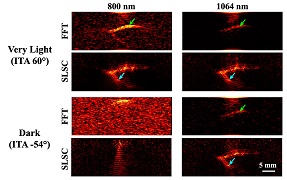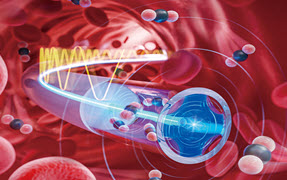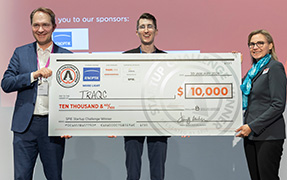Gerald Pearson: trapping the vast power of the sun

On 26 April 1954, a headline appeared on the front page of the New York Times: "Vast Power of the Sun Is Trapped by Battery Using Sand Ingredient." This headline foreshadowed the 2008 induction of Gerald L. Pearson into the National Inventors Hall of Fame for his co-invention of the silicon solar cell.
Efforts to capture solar energy for human use began decades before Gerald L. Pearson was born in Salem, Oregon, in 1905. His father was a fruit farmer with a fourth-grade education who insisted that Gerald and his two brothers go to college. Pearson studied physics at Willamette University in Salem, then earned a master's degree at Stanford University.
By the time Pearson was hired by Bell Labs in 1929, 90 years had passed since French physicist Edmond Becquerel, then a 19-year-old in his father's laboratory, measured a small voltage between platinum electrodes in an acidic solution containing silver chloride illuminated by sunlight. British engineer Willoughby Smith later discovered photoconductivity in selenium in 1873, and in 1883 American inventor Charles Edgar Fritts applied gold leaf to selenium to make the first solar cell. However, its anemic efficiency, less than one percent, made it impractical.
An important experiment in silicon physics at Bell Labs in 1940 also marked a big step in solar cells. Russell Ohl was studying how impurities affected silicon properties when he found that illuminating a cracked sample of silicon with different impurity levels on two sides produced a surprisingly strong voltage across the crack. It led to Ohl's observation of the first junction of silicon regions doped with positive and negative impurities—a key to the junction diode and transistor—as well as the first silicon solar cell.
Bell Labs made military projects top priority during World War II, but turned back to semiconductors in 1946, transferring Pearson into the program. After five years of war work, Pearson told historian Lillian Hoddeson, "we felt free as the wind."
Pearson was interested more in the scientific aspects of semiconductors than in making transistors. He did not work on the point-contact transistor that was the first type invented, but his research on semiconductor behavior and p-n junctions contributed to the junction transistor which came next. Pearson did develop the first useful silicon field-effect transistor, which he described at a 1953 meeting.
Meanwhile, a practical problem roused Bell Lab's interest in solar power. The dry cell batteries used to power remote telephone equipment degraded quickly in humid regions, and in 1952 Bell asked engineer Daryl Chapin to study other possible power sources. Chapin thought solar cells might work, but wanted more efficiency than selenium could offer, so he asked Pearson, a personal friend, about alternatives.
Pearson and Calvin Fuller had been studying how impurities affect silicon's properties, important for transistors and other semiconductor devices. Fuller gave Pearson a silicon sample doped with gallium to give it positive charge carriers, and suggested that Pearson dip it into hot lithium to add negative carriers. After connecting an ammeter to the sample, they turned on a lamp and saw the highest current flow ever recorded in a solar cell.
Pearson walked to Chapin's office and told him to drop selenium and switch to silicon. Yet, problems emerged: lithium migrated through the silicon and good electrical connections to the semiconductor were hard to make. First, they replaced the lithium with phosphorous, which helped but was not enough.
Then they tried a new recipe suggested by Fuller: doping the silicon with arsenic as negative carriers, then applying a very thin layer of boron to make positive carriers and form the p-n junction very close to the surface. Those changes also made good electrical contacts, allowing them to convert six percent of the solar energy into electricity, beating the one percent that solar-energy pioneer Mária Telkes, then at MIT, had reported for thermoelectric conversion in 1947. Six percent was the target for the telephone application, though Chapin calculated that an ideal silicon solar cell could reach 23 percent of sunlight into electricity.
Chapin, Fuller, and Pearson submitted a letter to the Journal of Applied Physics. Around the same time, the front page of the 27 January 1954 New York Times heralded an "atomic battery" produced by the RCA Corp. in which electrons emitted by radioactive strontium-90 generated electricity from a p-n junction in silicon. The RCA Corp. invention produced a microwatt of power per square yard of solar cell.
Bell Lab's solar cell made the front page of the Times shortly after on 26 April 1954, appearing between announcement of the first large-scale test of the Salk polio vaccine and a gangland killing in New York. A square meter of Bell's solar cell converted six percent of the incident solar energy into electricity, effectively leaving RCA's atomic battery in the dust. The Times projected solar cells might someday harness the "almost limitless energy of the sun for the uses of civilization."
Bell managers told Pearson the solar cell had received "the best newspaper publicity coverage ever in the history of the Bell system." But Pearson was not as impressed by the publicity, noting that the invention of the transistor earned only six inches on the Times obituary page. He told Hoddeson the solar cell "was the most important publicity-wise, but I think scientific-wise it may not have been."

The author's 1960 solar cell, which cost $2.25. Credit: Jeff Hecht
Pearson measured success by how much his inventions were used. When he totaled up sales of his inventions in 1969, they had reached $260 million (nearly $1.2 billion today). His best-selling invention at the time was the silicon rectifier at $154 million, followed by p-n-p-n devices at $65 million, $18 million in thermistors, $20 million in field effect transistors, and only $5.8 million in solar cells, just over two percent of the total.
Yet solar cells captured the public's imagination. Edmund Scientific sold them in their catalog in the 1960s—you can see my own here (above), which I purchased for $2.25. Crucially, solar cells powered the space race, since all satellites built to last more than a month required solar power. Looking back, Pearson acknowledged, "The scientific equipment on the Moon and on Mars wouldn't function if it weren't for solar cells."
Pearson died in 1987, too early to see solar rooftops, solar-power farms, or solar cells with efficiency above the 23 percent limit that Chapin predicted 67 years ago. If he was around today, the tremendous growth of solar power and its importance in controlling climate change might have changed his mind.
Jeff Hecht is an SPIE Member and freelancer who writes about science and technology.
| Enjoy this article? Get similar news in your inbox |
|



